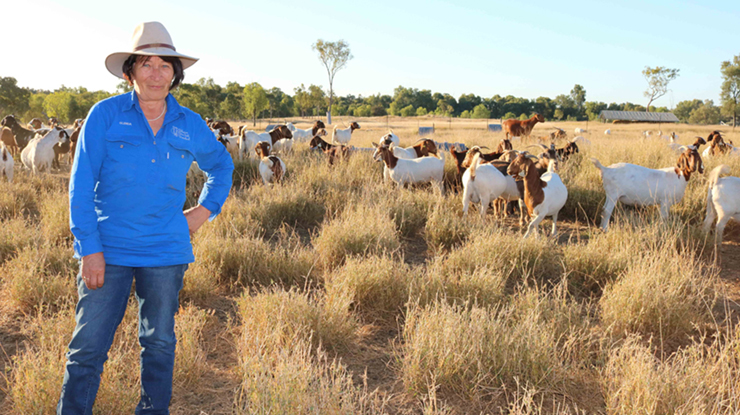 Queensland cattle, Boer goat and lamb producer Glenda Henry.
Queensland cattle, Boer goat and lamb producer Glenda Henry.
Getting goat transport right from the get-go
Taking the time to familiarise weaners with handling processes can pay dividends for producers and their livestock according to Queensland cattle, Boer goat and lamb producer Glenda Henry.
Glenda and her partner Collin Valler run Bellarine Boer Goats alongside their Brahman cattle and fat lambs over 6,500 acres in Emerald’s highlands.
According to Glenda, making livestock familiar with transport, yard handling and loading makes for faster and stress-free processes in the long run.
“With all animals, it comes back to them trusting you and not feeling threatened – then, they will cooperate,” Glenda explained.
“We do things here to make life safe and happy for the animals and handlers. When we wean them, we move them around paddocks in a trailer.
“It helps them become familiar with loading so it’s not such a frightening thing. It’s a big advantage to have done some trips.”
Originally cattle producers, the couple expanded into goats 10 years ago as a land management tool and said the goats have boosted pasture diversity and helped to control weeds.
“The goats have been a total benefit to the property,” Glenda said.
“They’ve helped more with balancing out the vegetation. They love parthenium, which is throughout our area.
“Parkinsonia and mimosa bushes are like chocolate cake to them. They’ve helped to balance our windmill and reed-type grasses.”
Making the best move
The couple regularly supply wether goats to a domestic market requiring three and a half hours transport to Mackay.
Glenda prefers to use trusted transporters or transporting their livestock themselves, and has a few transport fundamentals when preparing for a trip.
“The main goal is to have them calm when loaded,” Glenda said.
“We usually transport them in pairs or more. You don’t want them under or overloaded in the pens.”
Ensuring livestock have been appropriately prepared with sufficient time off feed and water for the journey is important as well, Glenda said.
“We yard them the day before they’re due to be loaded.
“We add electrolytes to their water to help alleviate the stress. Even though our animals are calm around people and we practice low-stress handling, it can be a stressful experience being loaded and transported.”
The length of the intended journey and season both inform how far in advance the livestock are taken off feed and water.
“It gives them a chance to empty out in the yards instead of the truck, so they’re not slipping over.”
A layer of straw will often be added into the truck or trailer to make it more comfortable for animals and help soak up anything dropped down.
Goats need the extra consideration of coverings on transport, Glenda advised.
“They’re incredible jumpers and climbers. Be aware – you need a lid on things. They will jump out.”
Glenda’s top tips for transporting goats
|



